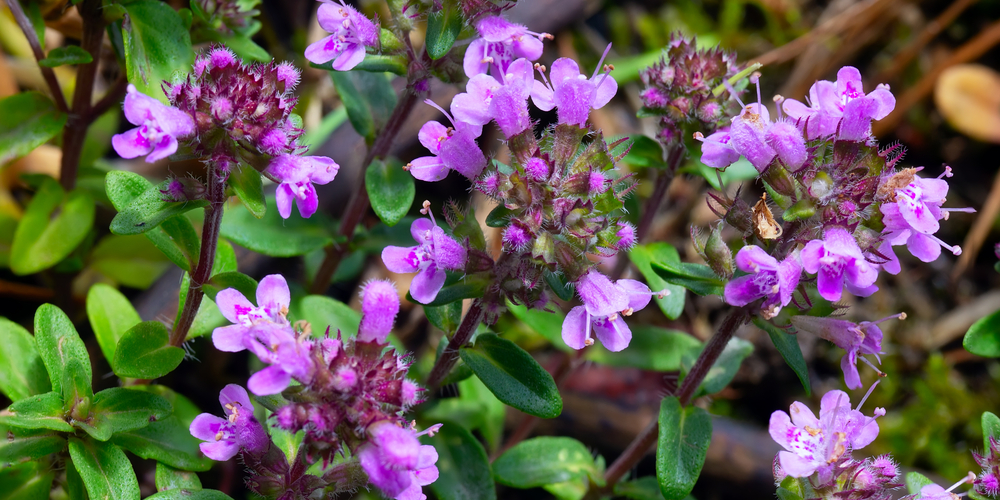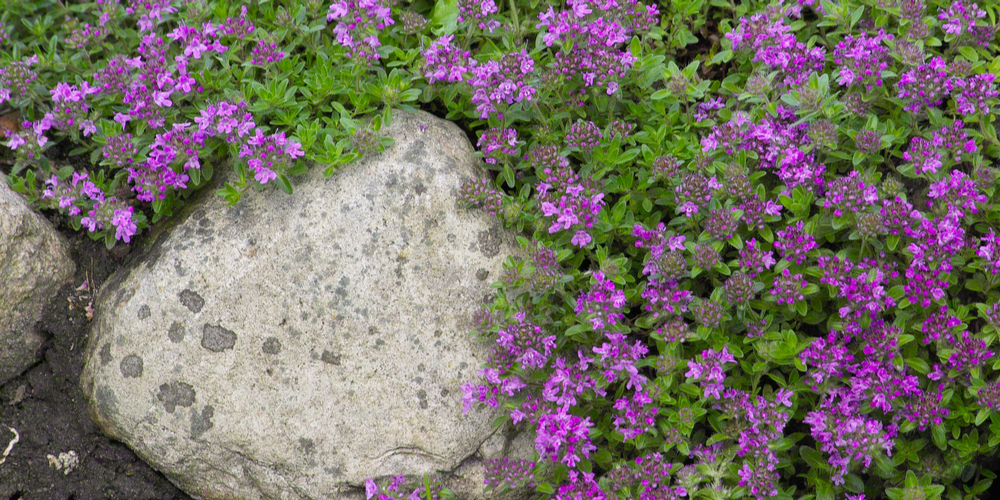Creeping thyme is an easy-to-grow variety of herb that works excellently as a lawn substitute. This delicate-looking ground cover thrives in almost any environment but performs better as a perennial in USDA hardiness zones between 4 and 9. While this plant cannot handle heavy foot traffic, you can safely add it in a walkway or between stepping stones. Let’s look at how to grow Creeping Thyme from seed?
Why Creeping Thyme?

Once established, this plant has minimal requirements: you’ll be able to enjoy a dense and colorful mat with little effort from your side.
Plus, this ground cover releases an attractive smell that will welcome you (and your guests) into your garden. You can harvest its leaves and use them in the kitchen to season your meals and add a pleasant flavor to your dishes.
Creeping thyme will not only make your garden look more colorful but also more alive: indeed, these plants attract plenty of pollinators, including bees and butterflies, making them the perfect companion plants for most species. Ground covers such as creeping thyme have plenty of benefits in any garden. They serve as natural mulch by surprising weeds and increasing water retention.
Additionally, they prevent erosion and shade the soil. So, all in all, adding creeping thyme to your garden, provided that you ensure it gets what it needs to thrive, is an excellent option to make your garden more attractive with little effort.
But can you grow Creeping Thyme from seeds? And how can you do that to make the most out of these plants? If you have these questions in mind, don’t worry: we are here to help. Here, you’ll find everything you should know about growing creeping thyme (and maintaining it).
How To Grow Creeping Thyme From Seeds
For starters, you must plant seeds after the danger of frost has passed. That might vary according to your USDA hardiness zone: always check your local weather and plant your creeping thyme accordingly. If you live in an area where winters are long and cold, don’t worry: you can always start your seeds indoors.
Growing this ground cover from seeds is not challenging. However, to increase the chances of success, you must follow our recommendations. Prepare an adequate bed for your plants by loosening the soil and removing weeds (and other plants that might get in the way). Then, scatter your seeds and press them lightly into the soil. Pushing them too hard into the ground might prevent the sunlight from hitting them, halting their growth. Water your seeds thoroughly, at least during the first weeks. Keep them moist but not wet: too much water will attract pests and disease and weaken your plants.
Expect seedlings to come out within 21 days from planting. If you decide to start creeping thyme seeds indoors, sow them six to eight weeks before the last frost. Move them in small containers with organic potting soil and mulch to keep them moist. Transplant them in the garden once they are about three to four inches long.
Don’t forget to space them to ensure they get enough space to grow! If you are afraid your seedlings won’t make it outdoors, you can slowly introduce them to the external conditions. Move your plants outside during the day and keep them indoors at night. Increase the amount of time spent outdoors by an hour each day until they are ready to stall all night long.
Creeping Thyme: Our Growing Tips
Creeping thyme thrives under full sun and in fast-draining soils. It doesn’t need fertilizer and adapts to various conditions, including sandy or rocky environments. Provided that you ensure they get at least six hours of sunlight each day, you’ll have no issues growing them.
These plants are resistant to drought: avoid overwatering them as they are susceptible to root rot. Once established, only give your creeping thyme occasional water: the plant will spread quickly and make your garden lush and healthy. You may have to thin or transplant divisions of your creeping thyme to other parts of your garden to allow each plant enough space to grow. Indeed, if the environment gets too crowded, your thyme plants will compete for sun and water, looking weaker and not so healthy.
Creeping Thyme From Seed: The Bottom Line
As you can see, growing creeping thyme from seeds is not as challenging as with other plants. Yes, you may have to be patient and provide your plants with adequate care at the start, but once they establish in your yard, these types of thyme won’t need much help from your seed to thrive.
